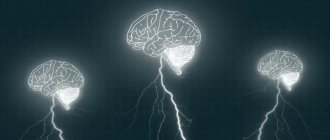When healthy adults are bothered by periodic headaches with dizziness, loss of ability to work, and they are associated with changes in weather, we can confidently say that this is cerebral angiodystonia. Unfortunately, the pathology is increasingly becoming “younger”. Violation of vascular tone is found in children. Especially during the period of increasing school stress and hormonal changes.
It is necessary to clearly define the terminology:
- “angiodystonia of cerebral vessels” repeats the same name in Latin and Russian (“angio” already means “vascular”), so competent doctors do not use such terms;
- pathology implies damage to both the arteries and the venous system of the brain;
- equally indicates both spasm and vasodilation, and most precisely, a violation of tone and an incorrect reaction;
- does not reflect a specific diagnosis, but represents the doctor’s reasoning or assumptions about the mechanisms of disturbance of a person’s well-being associated with cephalgia (headache).
There is no special code for this pathology in the International Classification of Diseases (ICD-10). The most appropriate class is G45 because it involves transient ischemic disorders and related syndromes.
A critical approach to recording such changes is always required. They may hide other certain diseases of the brain and blood vessels.
You can read about the causes of impaired vascular tone here. Cerebral angiodystonia, more than other types, depends on the coordinated work of the human autonomic nervous system.
Vein dilatation occurs when cerebral angiodystonia develops in young children during fright from an unfamiliar situation, environment, or stress when screaming.
What is cerebral angiodystonia?
It is generally accepted that problems with blood vessels often bother older people.
However, this does not always happen. In some cases, the disease develops in childhood or young adulthood. An example of such a pathology is cerebral angiodystonia of cerebral vessels. Typical manifestations of this disease are: sleep and memory disturbances, slow mental activity, dizziness. Focal symptoms are less common. Angiodystonia of cerebral vessels is most often a sign of some neurological disease. However, in some cases the cause cannot be determined. In this case, a diagnosis is made: dystonia of the hypo- or hypertonic type. In addition to headaches, a decrease or increase in blood pressure and fainting are often observed. This pathology means a change in the tone of cerebral vessels. Such disturbances may affect a specific area of the brain or the blood supply as a whole. The clinical picture observed during the disease depends on this.
Classification
Cerebral angiodystonia syndrome is classified in several ways:
By origin:
- Primary. Primary angiodystonia of a cerebral nature is an independent disease. It is also called neurogenic.
- Symptomatic. Violation of vascular tone acts as a symptom or complication of the underlying disease, for example, hypertension.
By localization:
- Local. Local disturbance of vascular tone is observed in one organ, as in cerebral angiodystonia.
- Systemic or diffuse cerebral angiodystonia. Violation of vascular tone is observed throughout the body.
With the flow:
- Constant angiodystonia. Manifests itself as persistent cerebral circulatory disorders.
- Crisis. It manifests itself as periodic sharp deterioration in well-being - this is cerebral angiodystonia with paroxysms.
By type of dystonia:
- Hypertensive type. It is observed with high blood pressure, when the blood vessels of the brain are in a state of spasm, the lumen of the vessel is reduced due to contraction of the muscular wall of the artery.
- Mixed type. It is characterized by fluctuations in the state of the walls of blood vessels, during which they can contract or relax. Depends on the current psychophysiological state.
- Hypotonic type. Occurs in people prone to low blood pressure. The walls of the vessels are relaxed and their lumen is increased.
By severity:
- Mild dystonia.
- Moderately severe cerebral angiodystonia.
- Severe cerebral angiodystonia.
The degree determines the severity of the clinical picture of vascular pathology of the brain.
Types of progression and symptoms of the disease
Cerebral angiodystonia can occur in several types:
- for hypertensive;
- according to hypotonic;
- according to mixed.
More details about each type of angiodystonia:
- When vascular spasm occurs, a person may experience attacks of sharp and sudden pain. A characteristic feature of the hypertensive type is pulsation in the temples, pain in the heart, the presence of arrhythmia and hypertension.
- The hypotonic type is caused by vasodilation, which leads to migraines and fainting. Loss of strength also occurs, a person loses the ability to perform any type of work - physical or mental. Memory loss (short-term) is sometimes possible.
- The mixed form differs in that its manifestations may coincide with the first two types. At this time, a person may experience a decrease in hearing and vision acuity, and a decrease in sense of smell. The patient also loses the ability to perceive new or complex information. Pain in the back and joints appears.
It is important to remember that pain with any type of disease can occur at any time of the day. This factor is not influenced by fatigue, overwork or emotional stress. Main area of pain:
- whiskey;
- parietal region;
- forehead.
The sensations are sharp, pulsating, aching. Sometimes angiodystonia causes depression and leads to difficulty breathing.
Signs of cerebral angiodystonia syndrome are varied in their manifestations. The main ones are severe, sometimes unbearable pain.
They can occur both during the day and at night, when a person is calm. Symptoms of the syndrome also include:
- dizziness (may occur several times a day);
- sleep disturbance (insomnia, light sleep);
- pressure changes;
- heaviness in the head;
- noise in ears;
- weakening of memory and attention;
- hearing and vision impairment.
Specialists are also able to identify such unpleasant and serious symptoms as:
- Cerebral angiodystonia of cerebral vessels: symptoms and treatment
- vasoconstriction (manifested in varying degrees of severity);
- depletion and weakening of blood flow;
- displacement of veins or arteries.
That is why it is very important to begin the process of diagnosis and therapeutic therapy in a timely manner.
Symptoms
The clinical picture of cerebral angiodystonia is nonspecific. General signs of cerebral angiodystonia:
- Emotional and mental disorders: frequent mood swings, irritability and fatigue, absent-mindedness, memory loss, rapid fatigue from simple work, shallow sleep, increased time to fall asleep, apathy, decreased interest in surrounding events and hobbies.
- Autonomic disorders: shortness of breath and irregular breathing rhythm, palpitations, fluctuations in blood pressure, increased heart rate.
The clinical picture consists of syndromes. The dominance of a particular syndrome depends on the congenital or acquired weakness of an organ or system. So, if the patient has a congenital heart defect, the dominant syndrome will be cardiac neurosis. List of syndromes combined with angiodystonia of cerebral vessels:
- Cardialgic. The patient complains of pain in the heart. Painful sensations are bursting, burning or aching in nature. Most often localized at the apex of the heart. The pain lasts from a few minutes to 1-2 hours. The pain goes away if the patient is distracted by something emotionally significant and interesting. Severe pain is usually accompanied by fear, anxiety, agitation and shortness of breath.
- Breathing disorder syndrome. It is observed in more than 85% of patients with angiodystonia. Typical symptoms: a feeling of lack of air, shortness of breath and suffocation, discomfort in the lungs and upper respiratory tract.
Crisis, or paroxysmal angiodystonia can be accompanied by crises of three types:
- Sympathoadrenal crisis. It is characterized by the following symptoms: sudden appearance of anxiety and fear;
- aching headache that occurs suddenly; the patient complains of a feeling of pulsation in the head;
- high blood pressure;
- feeling of strong heartbeat;
- pale and dry skin;
- trembling of limbs;
- increase in body temperature.
At the end of the first type of crisis, excessive urination and general weakness are observed.
- Parasympathetic crisis: bursting headache;
- nausea, vomiting;
- decreased blood pressure;
- decreased heart rate per minute, shortness of breath;
- dizziness;
- hyperhidrosis, moist and warm skin.
There are three degrees of severity of paroxysmal crises with angiodystonia:
- Easy. Manifests itself as a separate syndrome. The attack lasts no more than 20 minutes.
- Average. Symptoms include two syndromes simultaneously. The attack lasts from 20 minutes to 1 hour. After the crisis, exhaustion is observed, which lasts 1-2 days.
- Heavy. Manifested by 2 or more syndromes, severe autonomic dysfunction with cerebral angiodystonia and convulsive seizures. The attack lasts more than 1 hour. Exhaustion after an attack lasts 2-3 days. In adults, working capacity is reduced at this time.
Clinical picture of individual forms:
- Cerebral angiodystonia with venous dysfunction. It is based on a violation of the tone of the venous vessels of the brain. Because of this, venous outflow in the brain is disrupted and blood is retained. Symptoms similar to hypertensive-hydrocephalic syndrome occur: nausea, vomiting, aching headache, apathy, irritability, sensitivity to bright light and loud sounds.
- Signs of angiodystonia of cerebral vessels of the hypotensive type. Occurs if systolic blood pressure falls below 100 mmHg. Emotional and mental disorders are the same as with standard angiodystonia. Autonomic disorders are manifested by chilliness of the extremities and a tendency to faint due to insufficient blood supply to the brain. The skin is pale in appearance and cold and damp to the touch. During work, blood pressure is normal, but at rest it decreases. The tone of peripheral vessels decreases.
- Hypertensive type. The pathology occurs as a discirculatory encephalopathy. It is characterized by a decrease in psychophysiological indicators: memory, attention, pace of thinking, speed of reactions. Autonomic disorders come to the fore: an increase in heart rate per minute from 80 to 130, an increase in heart rate with excitement, extrasystole, visible pulsation of the vessels of the neck and head.
Cerebral angiodystonia in a teenager is caused by endocrinological changes in the body, which causes spontaneous outbursts of aggression, excessive sensitivity, and negativism. A transient mental state can provoke the psychosomatics of angiodystonia. Cerebral angiodystonia at 16 years of age in school-age children is the peak incidence.
Cerebral angiodystonia during pregnancy has a similar reason - wasting resources on adapting to a new lifestyle leads to psycho-emotional stress and psychosomatic disorders.
Rheoencephalography for angiodystonia of cerebral vessels
If there is a suspicion of angiodystonia of the cerebral vessels, rheoencephalography is performed. This method is also used when examining children. Rheoencephalography can detect circulatory disorders in the brain. This diagnostic method is safe, but it is prohibited to use it if there are wounds on the skin in the place where the electrodes need to be applied. People suffering from fungal diseases of the scalp should avoid rheoencephalography. It is not recommended to drink coffee or strong tea before the study, otherwise the accuracy of the study may decrease.
During the process of rheoencephalography, a person must be in a relaxed state: he sits comfortably on a special couch. The specialist places electrodes on the patient’s head, which are pre-treated with gel. The electrodes are fixed with a tape made of elastic material. During the procedure, special signals are sent to the brain: the monitor displays certain indicators characterizing the condition of the blood vessels. In modern devices, data is transferred directly to paper tape.
Diagnostics
Angiodystonia is a diagnosis of exclusion. It is set if no other organic and functional pathologies of the cerebral vessels are identified. Diagnostic searches can last for months, since the clinical picture is varied and nonspecific.
Diagnosis is carried out by a neurologist, endocrinologist, psychiatrist and cardiologist. Initially, a family history of autonomic dysfunction is established: whether immediate relatives had a disorder of vascular regulation of the brain. The presence of concomitant diseases is established. Typically, patients with dysregulation of vascular tone experience gastric and duodenal ulcers, bronchial asthma, skin diseases, allergies, hypertension, arrhythmias and endocrine diseases.
Instrumental diagnostic methods include electrocardiography, electroencephalography, computed tomography and functional tests using provoking drugs.
Pathology treatment methods
Treatment of angiodystonia is focused on eliminating the symptoms of the pathology; it includes the use of vasoactive drugs, painkillers, and sedatives. Patients also need a course of special physiotherapeutic procedures aimed at normalizing vascular tone. Patients are advised to adhere to a certain daily routine and eat right.
In the treatment of vascular diseases, water procedures are also used: baths with essential oils have a relaxing effect on the body. A contrast shower is used as a stimulating therapy. Medicines are prescribed by a doctor after a detailed examination of the patient. Beta-blockers and ACE inhibitors are used to lower blood pressure. For angiodystonia, antiarrhythmic drugs, vitamins, and medications with antioxidant properties may be needed.
Preventive techniques
To reduce the likelihood of developing pathology, you need to adhere to the rules of prevention. When angiodystonia develops in people, such actions can help get rid of the subsequent development of the disease or slow it down.
Adviсe:
- Exercise more.
- You need to devote enough time to rest.
- Walk outdoors more often.
- Properly selected diet.
- Lose or gain weight if necessary.
- You cannot smoke or drink alcohol.
- Constant use of medications, visiting a specialist for examination.
Many people do not understand what cerebral angiodystonia is, they think that they are just tired and feel slightly unwell. The disease develops calmly, complications and serious consequences are not observed, the quality of life of patients worsens many times . Therefore, you should immediately contact a medical specialist if you experience regular headaches.
Diseases affecting the brain significantly worsen the well-being of patients, and therefore require regular treatment. If therapy is not used in a timely manner, diseases can significantly disrupt the processes in such an organ. This negatively affects all body systems. Vascular diseases disrupt the blood supply to the head and other parts. Due to this, the patient suffers from pain and associated symptoms.
Concomitant diseases
Violation of vascular tone is accompanied by many diseases:
- Encephalopathy. This disease occurs due to a chronic cerebral circulation disorder, resulting in the death of brain cells. Accompanied by intellectual, vegetative and emotional disorders. At first, the disease is functional and reversible, but if atherosclerosis joins angiodystonia over time, the defect becomes irreversible.
- Hypertonic disease. The pathology is based on a sustained increase in systolic blood pressure above 140 mm Hg. Due to the increased tone of the vascular walls, the minute-by-minute volume of blood circulation in the large and small vessels of the brain decreases, which is why it suffers from ischemia and hypoxia.
- Cardiopsychoneurosis. It is characterized by pain in the heart, rhythm disturbances and fluctuations in blood pressure. Usually has a mixed type.
Causes
Cerebral angiodystonia of cerebral vessels has the following causes:
- Diseases of the endocrine organs: pheochromocytoma, hyperthyroidism, hypothyroidism, diabetes mellitus.
- Dysregulation of the autonomic nervous system.
- Neuroinfections: meningitis, encephalitis, meningoencephalitis.
- Consequences of traumatic brain injury.
- Acute or chronic intoxication with alcohol, nicotine, drugs, fumes, food poisoning, hangover.
- Occupational diseases: vibration disease, exposure to loud noise.
- Psycho-emotional disorders due to prolonged stress, lack of sleep, neuropsychic stress.
- Diseases of internal organs.
- Arterial hypertension, hypertension.
- Severe cerebral angiodystonia in children occurs due to congenital pathologies of the central nervous system, for example, against the background of problematic pregnancy
Violation of vascular tone is often considered a psychosomatic pathology. An unconstructive approach (alcoholism, addictive behavior) or a person’s lack of skills to eliminate mental stress leads to chronic stress, psycho-emotional tension and disruption of the autonomic nervous system.
What is a disease?
This disease is caused by a violation of the tone of the arteries in the head. This pathology does not allow the vessels to adapt normally to any changes - both external and internal. The result of cerebral angiodystonia is inadequate functioning of the veins, their function is disrupted, which disrupts regional blood flow, which affects the activity of all body systems. Today, both adults and children are susceptible to a similar illness, although previously the disease was usually diagnosed in older people.
The cause of this disorder is damage to the vascular walls, which occurs under the influence of another disease. This disease is considered very serious by doctors and requires immediate treatment. As soon as characteristic signs appear, you should immediately consult a doctor, since the development of pathology can lead to disability and even death. According to the classification of the disease ICD-10 revision, it is assigned a code - G45, but this is the most suitable option for the disorder, which is usually used for ischemic diseases. Specifically, angiocerebral dystonia does not have a separate code in the international classification of diseases.
To understand this complex name, you need to define the term itself. Angiodystonia is a mixture of two words from Latin and Russian. Angio means “vascular,” and “dystonia” means vascular disease. The pathological process extends not only to arteries of all types, but also to the resistive region, which includes capillaries, arterioles and other types of blood vessels. The venous system of the brain is also subject to destructive effects - this means both their spasm and expansion.







